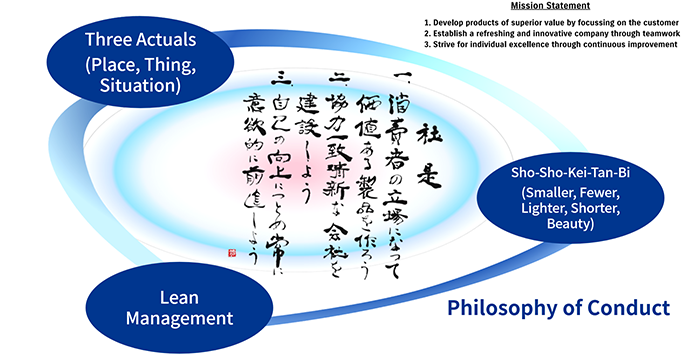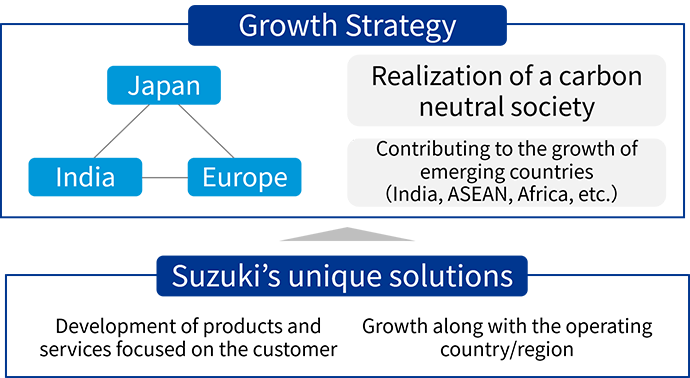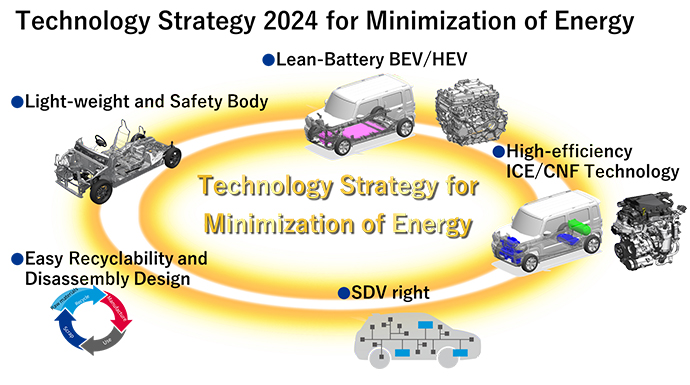INICIO › FOROS › NOVEDADES › Actualidad del motor › Noticias SUZUKI
Etiquetado: Grupo Suzuki, Noticias de Suzuki, Noticias SUZUKI, Suzuki, Suzuki foro
- Este debate tiene 53 respuestas, 12 mensajes y ha sido actualizado por última vez el hace 1 semana, 2 días por
DTM995.
-
Es que tienen modelos para cada franja de dimensiones prácticamente:
- 3,5-3,6 metros: Alto y S-Presso
- 3,6-3,7 metros: Wagon-R y Celerio
- 3,7-3,8 metros: Ignis
Y así sucesivamente. Los diferencian por diseño, equipo, y si son más racionales (valor-precio) o de diseño más especial.
Y les funciona. Al menos en India la mayoría son modelos top ventas.
Siguiendo con los renombrados Suzuki bajo logo toyota , el Suzuki Ertiga también existe como Toyota Rumion, un práctico 7 plazas , yo he subido en la versión Suzuki y es uno de los vehículos mejor aprovechados , apenas cambian logos entre marcas , nada más en este caso
No entiendo por qué ponen faros taaaaaaan grandes como los traseros
Suzuki desarrollará junto con Inmotive un cambio eléctrico de 2 velocidades.
Con este acuerdo de desarrollo conjunto para la transmisión EV de 2 velocidades, Suzuki cree que puede ampliar la autonomía de los vehículos eléctricos mediante el uso eficiente del par motor, y al mismo tiempo reducir el coste debido al uso de un tren motriz eléctrico más pequeña. Con esto también se consigue mejorar el rendimiento en los diferentes modos de conducción.
Fuente: Suzuki
Suzuki anuncia su proyecto de crecimiento MY2030
Voy a poner un poco, el resto en la nota de prensa, en inglés
– Neutralidad de carbono. En Japón y Europa en 2050, en la India en 2070
– Nuevos vehículos eléctricos
- Japón: 6 modelos en total. Varios comerciales ligeros en 2023, varios SUVS y coches pequeños en 2030
- Europa: vehículos eléctricos en 2024. varios SUVs y vehículos del segmento B para 2030
- India: 1 vehículo EV para 2023. 6 modelos para 2030. No sólo eléctricos sino también de combustión interna neutral en carbono
La nota de prensa
Suzuki Announces Growth Strategy for FY2030
Suzuki Motor Corporation announced its Growth Strategy for FY2030.
With the motto to deliver “value-packed products” by focusing on the customer, Suzuki will carry out its unique Growth Strategy for FY2030 by operating under the principle of manufacturing “Sho-Sho-Kei-Tan-Bi (Smaller, Fewer, Lighter, Shorter, Beauty)”, “Lean Management” which emphasizes flexibility, agility, and the challenging spirit, and the “Three Actuals” principle, which omits impracticality and focuses on the actual place, thing, and situation.
Outline of the Growth Strategy
For FY2030, Suzuki will contribute to the realization of a carbon neutral society and the economic growth of emerging countries such as India, ASEAN, and Africa, with our main business regions, Japan, India, and Europe, as the core.
We will focus on creating solutions that are unique to Suzuki, which are to develop products and services focused on the customer, and grow along with the operating countries and regions.
Major Initiatives for FY2030
<Carbon Neutrality>
Based on the target date set by each government, Suzuki aims to achieve carbon neutrality in Japan and Europe by 2050 and in India by 2070.
We will continue to strive to achieve our carbon neutral goals for each region, based on our mindset to expand our customers’ choices and deliver products and services that meet the needs of each region.~ Products ~
Automobiles
In Japan, starting with the introduction of commercial mini-vehicle battery EVs in FY2023, we plan to introduce compact SUVs and passenger mini-vehicles, with 6 models to be launched by FY2030. In addition, we will develop new hybrids for mini and compact vehicles, and by combining them with battery EVs, we will offer various options for our customers.
In Europe, we will introduce battery EVs in FY2024, expand to SUVs and B-segments, with 5 models to be launched by FY2030. We will respond flexibly to environmental regulations and customer needs in each European country.
In India, we will introduce the SUV battery EV announced at the Auto Expo 2023 in FY2024, with 6 models to be launched by FY2030. To provide a full range of products and services, Suzuki will provide not only battery EVs but also carbon neutral internal combustion engine vehicles that use CNG, biogas, and ethanol mixed fuels.(Battery EV introduction plan)
Region Time of Introduction Forecast by FY2030 No. of models Battery EV ratio Japan FY2023 6 20% Europe FY2024 5 80% India FY2024 6 15% Motorcycles
For small and mid-sized motorcycles, which are used for daily transportation such as commuting to work, school or shopping, we will introduce a battery EV in FY2024. We plan to launch 8 models by FY2030 with a battery EV ratio of 25%. For large motorcycles for leisure purposes, we are considering adopting carbon neutral fuels.
Outboard motors
For small outboard motors that are often used in lakes and rivers, we will introduce battery EVs in FY2024. We plan to launch 5 models by FY2030 with a battery EV ratio of 5%. For large outboard motors used in the ocean, we are considering adopting carbon neutral fuels.
New Electric Mobility
Suzuki has proposed a variety of electric mobility options, including the electro senior vehicle, which is a new mode of transportation for people who have voluntarily returned their driver’s licenses, the KUPO, which is an evolution of the senior vehicles, and the Mobile Mover*, a multi-purpose robotic dolly being developed in collaboration with M2 Labo. We will take on the challenge of small mobility which supports our lives in new market segments created by the diversification of customer needs and changes in the environment.
*Mobile Mover is a registered trademark of M2 Labo.
~ Manufacturing ~
Suzuki will challenge to achieve carbon neutrality of domestic plants in FY2035.
Suzuki Smart Factory Creation
We are promoting the Suzuki Smart Factory Creation by drawing out how manufacturing should be in 2030, so that we continue to become a company that secures people’s means of mobility worldwide. By combining Suzuki’s principle of manufacturing “Sho-Sho-Kei-Tan-Bi (Smaller, Fewer, Lighter, Shorter, Beauty)” with digitalization, we will optimize, minimize, and simplify the flow of data, things, and energy. Through these initiatives, we will become lean and tackle for carbon neutrality.
Initiatives by domestic plants
At the Kosai Plant, which is Suzuki’s largest production hub in Japan, efforts are made to reduce CO2 emission of painting facilities by 30% through renewal of painting facilities and improvement of painting technologies for efficient and optimal use of energy. The plant also produces green hydrogen from renewable energies including solar power generation. The hydrogen is utilized for verification test of fuel cell transporter, which started from the end of 2022.
At the Hamamatsu Plant, which is the motorcycle production hub, through reduction of energy use and conversion into renewable energy including the expansion of solar power generation facilities, the plant will now target to achieve carbon neutrality in FY2027, earlier than its initial target of FY2030. By utilizing the know-hows earned at the Hamamatsu Plant to other plants, we will make initiatives to achieve carbon neutrality of all domestic plants in FY2035.~ Biogas business in India ~
While we expect the Indian market to grow toward FY2030, we also expect that increase in total CO2 emission amount is unavoidable, regardless of reduction in CO2 emission from products. We will challenge to strike a balance between increasing sales units and reducing total CO2 emission amount.
Suzuki’s unique initiative to tackle this challenge is the biogas business, in which biogas derived from cow dungs, which are dairy wastes that can be seen mainly in India’s rural area, will be produced and supplied. This biogas can be used for Suzuki’s CNG models that account for approximately 70% of CNG car market in India.
Suzuki signed an MoU with the Indian government agency National Dairy Development Board and Banas Dairy, Asia’s largest dairy manufacturer, to conduct verification of biogas. We also invested in Fujisan Asagiri Biomass LLC. that makes power generation from biogas derived from cow dungs in Japan, and are beginning its study.
We believe that the biogas business in India not only contributes to carbon neutrality, but also promotes economic growth and contribute to the society of India. We are also in view of expanding the business to other farming areas in regions including Africa, ASEAN, and Japan in the future.Suzuki, the market leader of India’s automobile market, contributing to carbon neutrality and economic growth of emerging countries, is consistent with the intent of the Paris Agreement, which requires harmony between developed countries and emerging countries for reduction of CO2 emission. We believe that we can contribute to our stakeholders throughout the world.
<R&D Structure and Cooperation with Outside Partners>
Suzuki headquarters, Yokohama Lab., Suzuki R&D Center India, and Maruti Suzuki will cooperate for efficient development by sharing the development in each field of future technologies, advanced technologies, and mass-production technologies. Also, the Suzuki Innovation Center is exploring new connections and innovations for Suzuki to thoroughly take root in India. We will enhance our manufacturing strength by also cooperating with outside partners including start-up companies, Suzuki Suppliers Association, and cooperation with universities in Japan and India.
We will deepen our cooperation relationship with Toyota Motor Corporation while continuing to be a competitor, and aim for sustainable growth and conquer various issues surrounding the automobile industry. Through the cooperation, we will cooperate in development of advanced technologies including autonomous and battery of electrified cars, business expansion in promising emerging countries, efforts for carbon neutrality in India, as well as formation of a recycling-based society that considers the environment.
The Suzuki Global Ventures, a corporate venture capital fund established in 2022, is accelerating the co-creation activities with start-up companies by exceeding the framework of each company and their conventional businesses. We will make investments in areas that serve to solve customer and social issues, and contribute to development of ecosystem that grows with start-up companies.<R&D Expenses, Capital Expenditures>
We will invest 2 trillion Yen in R&D expenses and 2.5 trillion Yen in capital expenditures, a total of 4.5 trillion Yen by FY2030. Of the 4.5 trillion Yen, 2 trillion Yen will be electrification-related investments, of which 500 billion Yen will be battery-related investments.
2 trillion Yen is planned to be invested for R&D expenses in areas including carbon neutrality such as electrification and biogas, as well as autonomous.
2.5 trillion Yen is planned to be invested for capital expenditures in facilities including construction of BEV battery plant and renewable energy facilities.<Net Sales Target>
Consolidated net sales forecast for FY2022 is 4.5 trillion Yen, which is growing at a pace to exceed the 4.8 trillion Yen target for FY2025 set in the mid-term management plan. We would like to grow in line with the emerging countries by contributing to their growth. We will challenge to double the FY2021 net sales result of 3.5 trillion Yen to 7 trillion Yen in FY2030.
In the midst of once in a hundred years of great transformation, Suzuki believes that it is important to have a sense of “excitement”, “energetic”, and “unique” in our products, even when we are challenging to strike a balance between carbon neutrality and contribution to growth of emerging countries. Our automobiles, motorcycles, outboard motors, and electro senior vehicles have always received enthusiastic support from our customers, by being practical yet having emotional characters.
Suzuki employees throughout the world will unite as one to continue our challenges so that we can deliver products and services that support the daily lives of customers worldwide while being eco-friendly, the one that’s always besides you to depend on, like a lifestyle partner.Pues pienso que ni tanto ni tan calvo.
Lo más prudente haciendo las cosas bien sería algo tipo 2050. La industria no cambia en 2 díasTeaser de los futuros modelo eléctricos para los diferentes mercados.




Fuente: Suzuki
El intercambio de modelos continúa entre toyota y Suzuki esta vez el Toyota innova recibe frontal Suzuki
¿Veremos sus kei-car por Europa?
Es lo que está estudiando la marca, la viabilidad de meter sus cochecitos pequeños en Europa. Pensaban en traerlos exclusivamente eléctricos, pero también podrían traer los hibridos
https://www.autonocion.com/suzuki-estudia-lanzar-keicars-europa/
Pues a precio razonable me parece una genialidad, seguramente venda algunos. por que al final son pequeños pero habitables.
si citroen y Dacia están vendiendo los ami y spring, Suzuki puede vender sus kei cars
Suzuki muestra su estrategia tecnológica para los próximos 10 años.

Más ligeros y seguros.
Los vehículos compactos y ligeros, que son la especialidad de Suzuki, no sólo reducen las emisiones de CO2 durante su uso, sino que también reducen los recursos y las emisiones de CO2 durante la producción, contribuyendo así a la conservación de los recursos y a la reducción del CO2 . Seguiremos
desarrollando la carrocería ligera y segura “HEARTECT” y también trabajaremos para minimizar el consumo de energía mediante la tecnología de reducción de peso.Baterías de bajo consumo.
Con el objetivo de proporcionar a nuestros clientes los vehículos eléctricos más eficientes energéticamente en función de la relación de energía renovable y las condiciones de uso en cada país y región, Suzuki desarrollará vehículos eléctricos que minimicen el consumo de energía combinando componentes que incorporan “Sho-Sho-Kei-Tan-Bi”, como una unidad eléctrica pequeña y eficiente y una batería pequeña y ligera.
Motores ICE de alta eficiencia.
En 2023, hemos desarrollado un motor de alta eficiencia (el motor Z12E) que persigue una combustión mejorada, que es el núcleo de los motores de combustión interna, y ha logrado una eficiencia térmica máxima del 40 %. En el futuro, ampliaremos este motor de alta eficiencia a todo el mundo y lograremos minimizar el consumo de energía mediante combustible neutro en carbono e híbridos de próxima generación.
Vehículos definidos por software (SDV).
También en el campo de SDV, Suzuki desarrollará y proporcionará a nuestros clientes el “SDV correcto”, un sistema asequible que crea valor para los vehículos al incorporar la minimización del consumo de energía con “Sho-Sho-Kei-Tan-Bi”.
Facilitaremos su uso al actualizar su software, con la mejor combinación de actualizaciones por cable e inalámbricas (OTA). Desarrollaremos el SDV que haga que los clientes sientan “Esto está bien, esto es lo que quiero” al compartir el hardware para reducir los costos de los componentes y reutilizar el software para reducir los costos de desarrollo.Diseño de alta reciclabilidad y desmontaje.
En el futuro, Suzuki logrará un consumo mínimo de energía con una economía circular, que consiste en ahorrar el uso total de recursos mediante el diseño de productos que se puedan desmontar fácilmente teniendo en cuenta el reciclaje y la reutilización.
Fuente: Suzuki
- Debes estar registrado para responder a este debate.



